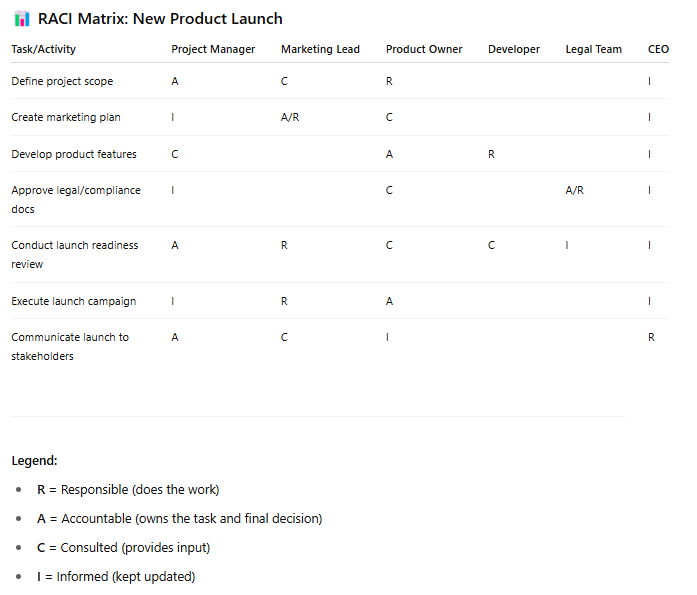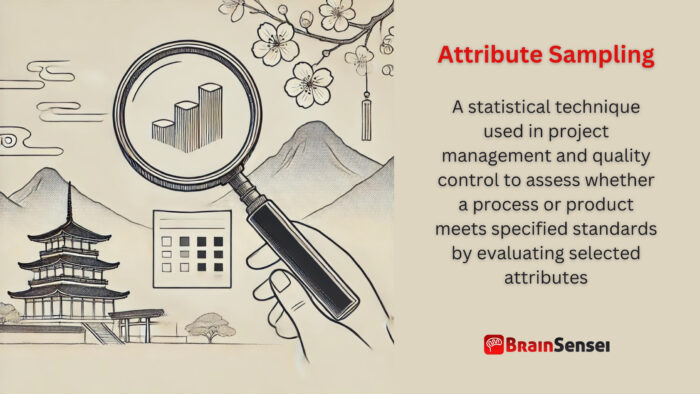
Attribute Sampling
What is Attribute Sampling?
Attribute sampling is a statistical technique used in project management and quality control to assess whether a process or product meets specified standards by evaluating selected attributes. It involves inspecting a sample to determine if specific characteristics are present or absent, often resulting in a pass/fail or yes/no outcome. This method helps project managers make data-driven decisions about quality performance.
Key Takeaways
- Attribute sampling focuses on binary outcomes: present/absent, conforming/non-conforming.
- It supports efficient quality control by sampling a subset rather than the entire population.
- Commonly applied in manufacturing, software testing, and other process-driven industries.
- Parameters like sample size and acceptance criteria define attribute sampling plans.
- It complements variable sampling, which measures data on a continuous scale.
Understanding Attribute Sampling
How It Works
Attribute sampling involves selecting a random sample from a larger population and evaluating each sample unit against predetermined quality attributes. The process typically follows these steps:
- Define Sampling Plan: Identify the attributes for inspection, sample size, and acceptance criteria.
- Select Sample: Randomly select items from the population.
- Inspect Sample: Evaluate the sample items for attribute compliance.
- Decision Making: Accept or reject the lot based on the sample’s compliance results.
Notes
- Sample sizes should be statistically significant for reliable results.
- Misidentification of attributes can lead to inaccurate conclusions.
- The sampling plan should align with project goals and regulatory standards.
- Regular review of sampling plans ensures continued effectiveness.
- Less detailed than variable sampling but quicker and more cost-effective.
Related Terms
- Variable Sampling: Measures data on a continuous scale to assess process performance
- Acceptance Sampling: A quality control technique that inspects a sample to decide if a batch meets the requirements
- Statistical Process Control (SPC): Uses statistical methods to monitor and control processes
- Quality Assurance (QA): A proactive approach to ensure quality standards
- Defect Density: The number of defects found in a product relative to its size
Examples of Attribute Sampling
Manufacturing (Energy & Utilities)
A solar panel manufacturer uses attribute sampling to ensure product quality. Inspectors randomly select panels from a production batch and check for specific defects like cracks or broken connections. They reject the entire batch if the defective panels exceed the acceptance threshold. This approach helps maintain consistent product performance in renewable energy projects. Attribute sampling allows the manufacturer to manage resources efficiently, focusing inspection efforts on samples rather than every individual panel. The sampling plan may involve different levels of inspection based on production volume, ensuring that increased production does not compromise quality. Over time, this technique has proven essential in identifying systemic issues such as production line inefficiencies or material quality issues, and driving process improvements.
Software Testing (IT & Software)
A software development team applies attribute sampling during system testing. Testers execute a predefined set of test cases and check if each case passes or fails. If the failure rate surpasses the acceptable limit, the team conducts a more comprehensive analysis to address systemic issues, ensuring software reliability. For instance, testers might inspect login functionality in a web application project by running a sample of login attempts. If many login failures occur, developers revisit the authentication module. Attribute sampling provides a scalable approach to managing testing efforts across large, complex applications without overwhelming manual testing resources.
Healthcare Equipment (Biotechnology & Life Sciences)
A medical device manufacturer uses attribute sampling to inspect surgical instruments for surface imperfections or manufacturing defects. Inspectors evaluate a sample and decide whether the batch can be distributed based on the defect count. This practice is crucial for patient safety and regulatory compliance. The company follows strict regulatory guidelines, using attribute sampling to document inspection outcomes. For example, during a routine inspection of surgical scissors, inspectors check for defects like rough edges or misalignment. Specialists determine the sample size and acceptance criteria based on historical defect rates, ensuring consistency. In one instance, they identified an uptick in surface defects, prompting a supplier review and corrective actions.
Attribute sampling, with its straightforward, binary nature, is ideal for initial quality assessments. However, its success depends on the clarity of attribute definitions and adherence to sampling plans. To further enhance its reliability, training programs for inspectors and regular process reviews are crucial. These measures provide a sense of security about the consistent quality and regulatory compliance that attribute sampling can contribute across industries.
Use Cases of Attribute Sampling
United States (Construction Projects)
In large-scale construction projects, attribute sampling ensures compliance with safety standards. For example, inspectors might sample concrete batches to verify proper curing. If too many samples fail, the team investigates potential causes, like incorrect material proportions, preventing structural failures. In this context, it involves defining key attributes such as compressive strength and setting time, then randomly sampling batches throughout the construction phase. If defects are detected, project managers analyze patterns to identify potential causes. This approach minimizes the risk of structural issues while optimizing the use of materials and labour.
Additionally, attribute sampling helps with regulatory compliance. Construction projects in the United States often adhere to organizations like the American Concrete Institute (ACI) guidelines. Construction teams can provide documented evidence of compliance using a systematic attribute sampling plan. In one high-rise project in New York City, attribute sampling revealed inconsistent concrete mixes. Investigating the issue led to improved supplier communication and revised mixing procedures, ensuring long-term structural integrity.
Germany (Automotive Manufacturing)
A German automotive manufacturer employs attribute sampling to assess the assembly quality of car components. Inspectors check selected vehicles for correct part installation and functionality. The insights guide adjustments in production processes, improving overall quality and customer satisfaction. In this industry, they monitored attributes like bolt torque, weld integrity, and panel alignment. By tracking defect trends across different assembly lines, they can pinpoint underperforming stations and implement targeted improvements.
The impact of attribute sampling extends beyond assembly lines. European regulations, including ISO/TS 16949 for automotive quality management, require documented quality control processes. Attribute sampling supports compliance by offering objective, verifiable inspection records. For instance, a Stuttgart-based car manufacturer detected a spike in misaligned door panels through attribute sampling. Corrective actions included technician training and process reengineering, reducing rework costs by 15%.
India (Pharmaceutical Packaging)
A pharmaceutical company in India uses attribute sampling to verify packaging integrity. Inspectors sample medicine packs to check for correct labelling and intact seals—non-conforming samples prompt investigations into packaging line performance, safeguarding patient health. Packaging errors in this highly regulated industry can result in severe consequences, including product recalls and regulatory penalties.
To implement attribute sampling effectively, the company defines critical packaging attributes: label accuracy, seal integrity, and tamper-evident features. Routine sampling monitors packaging lines, and inspectors log the results in compliance reports. During one inspection cycle, attribute sampling identified a higher-than-normal incidence of seal defects. Investigations traced the issue to a worn sealing machine component, which the technicians promptly replaced.
The company’s experience highlights the proactive benefits of attribute sampling. By identifying and addressing quality issues early, the company avoided a potential product recall and maintained its reputation for reliable, safe packaging.
These diverse use cases illustrate the adaptability of attribute sampling across industries and geographic regions. From construction to pharmaceuticals, the method supports consistent, reliable quality control. Success depends on selecting relevant attributes, using statistically valid sample sizes, and effectively training inspection personnel.
Best Practices for Attribute Sampling
Adequate attribute sampling requires careful planning and execution. Inconsistent sampling practices can lead to unreliable quality assessments and increased costs. To avoid such pitfalls, project managers should:
Define Clear Sampling Criteria
Specify the attributes to inspect and the pass/fail criteria. Clear criteria prevent confusion and ensure consistency across inspections.
Use Statistically Valid Sample Sizes
Ensure that samples accurately represent the entire population. An inadequate sample size can lead to misleading conclusions, while a vast sample may waste resources.
Train Inspectors Thoroughly
Equip personnel with the necessary skills to identify attribute non-conformance correctly. Training should include both theoretical knowledge and practical application.
Regularly Review Sampling Plans
Adjust plans as processes evolve to maintain accuracy. Process improvements, new regulations, or changes in production volume might necessitate updating the sampling plan.
Integrate with Quality Management Systems
Align sampling practices with broader quality assurance efforts. Integration facilitates real-time data analysis and supports continuous improvement initiatives.
Additionally, project managers should document the rationale behind sampling decisions. This documentation aids in audits, process reviews, and continuous improvement efforts. Proactively addressing potential issues—such as unclear attribute definitions or inconsistent sampling frequencies—can significantly improve sampling accuracy and reliability.
One case study from a manufacturing firm illustrates these best practices. The firm implemented attribute sampling to assess product dimensions. Initially, unclear criteria for attribute conformity resulted in high defect variability. After revising criteria, increasing sample size, and retraining inspectors, the firm reduced its defect rate by 30%. This outcome underscores the importance of clarity, training, and regular review in attribute sampling.
Failing to follow these practices can result in undetected defects, rework, and potential project delays. In regulated industries like pharmaceuticals and aerospace, such failures can have severe financial and legal implications, making best practices even more critical.
Common Mistakes and Issues
Attribute sampling is a powerful tool for quality control, but its effectiveness depends on proper implementation. Missteps in the process can lead to inaccurate conclusions, quality failures, and increased costs. Below, we explore common mistakes, their causes, and how to avoid them.
Insufficient Sample Size
One of the most common mistakes in attribute sampling is using an insufficient sample size. A smaller sample might seem cost-effective initially but can result in unreliable data. For instance, a manufacturer once reduced their sample size to save time and expenses. However, this decision led to undetected defects, culminating in a large-scale product recall and reputational damage.
To avoid this, project managers should use statistically significant sample sizes based on the population size and the expected defect rate. Establishing sampling standards like ANSI/ASQ Z1.4 can provide reliable guidelines for determining sample sizes.
Poorly Defined Attributes
Clarity is critical when defining the attributes for inspection. Vague or ambiguous attribute definitions can confuse inspectors, resulting in inconsistent evaluations. For example, a software development team defined an attribute as “a user-friendly interface” without specifying measurable criteria. As a result, testers disagreed on whether certain features passed the test.
To mitigate this risk, teams should establish objective, measurable attribute definitions. For software testing, a “user-friendly interface” can be defined as “an interface where users can complete core tasks within three clicks with a success rate of 95% in usability tests.”
Inconsistent Sampling Procedures
Inconsistent application of sampling procedures undermines the reliability of this technique. Variability in sample selection, inspection techniques, or documentation can distort findings. Different inspectors applied inconsistent sampling criteria in one construction project across various sites. This inconsistency led to an uneven quality assessment and structural integrity issues.
Implementing standardized procedures, supported by regular training sessions and periodic audits, ensures consistency across teams and locations. Every inspection should include detailed documentation to track deviations and facilitate process improvements.
Inadequate Inspector Training
The effectiveness of sampling heavily depends on the skills of the inspectors. Inadequately trained inspectors might overlook defects or misapply criteria. A pharmaceutical company experienced a spike in packaging errors after hiring new inspectors without sufficient training on attribute definitions and sampling protocols.
Organizations should invest in comprehensive, ongoing training programs. These programs should cover attribute identification, defect classification, and precisely following sampling protocols. Practical workshops and real-world simulations can enhance understanding and retention.
Misinterpreting Attribute Sampling Results
Misinterpreting sampling results can lead to faulty conclusions and misguided decisions. For instance, a retailer might misinterpret a high defect rate as a supplier failure when the real issue was the transportation process. Analyzing results within the broader process context helps pinpoint the root cause accurately.
Statistical training for decision-makers can help prevent such errors. Tools like control charts and Pareto analysis provide a clearer picture of the quality of the landscape.
Overreliance on Attribute Sampling
While it is valuable, relying on it may overlook subtle process variations. A manufacturing firm focused solely on pass/fail inspections missed early signs of a dimensional drift in product specifications. This oversight eventually caused compatibility issues in product assembly.
Combining attribute and variable sampling can provide a more nuanced view of process performance. Attribute sampling ensures compliance with defined standards, while variable sampling tracks gradual shifts in performance metrics.
Ignoring Corrective Actions
The ultimate goal of attribute sampling is to drive continuous improvement. Unfortunately, some organizations stop at defect detection without investigating root causes or implementing corrective actions. For example, a packaging company repeatedly rejected batches due to misaligned labels but failed to examine the machinery calibration issue causing the defect.
Effective corrective action involves documenting defects, analyzing root causes using tools like the Fishbone Diagram or 5 Whys, and implementing process changes. Regular follow-ups verify the effectiveness of these actions.
Real-World Case Study: A Cautionary Tale
A mid-sized electronics manufacturer illustrates the consequences of neglecting best practices in attribute sampling. The company implemented attribute sampling to inspect circuit boards but underestimated the required sample size. Initially, the approach seemed successful, as defect rates remained low. However, a large shipment of boards later failed in the field due to undetected soldering issues.
Investigations revealed several mistakes:
- Technicians calculated the sample size based on outdated defect data.
- Inspectors received inconsistent training across shifts.
- Attribute definitions were overly broad, causing variability in defect classification.
The company responded by recalculating sample sizes using recent defect rates, standardizing training protocols, and refining attribute definitions. Field failures dropped by 40% within six months, demonstrating the importance of adhering to attribute sampling best practices.
Attribute sampling is essential for maintaining quality in various industries, from manufacturing to software development. However, its success depends on well-defined attributes, adequate training, consistent procedures, and a commitment to continuous improvement. Organizations can leverage attribute sampling to make informed decisions, optimize processes, and maintain high-quality standards by recognizing and avoiding these common mistakes.
Frequently Asked Questions (FAQs)
What is the primary purpose of attribute sampling?
Attribute sampling helps evaluate whether a process or product meets specified standards by inspecting selected attributes. It supports quality control without examining every unit.
How does attribute sampling differ from variable sampling?
Attribute sampling assesses the presence or absence of specific characteristics, typically resulting in binary outcomes. Variable sampling measures data continuously, providing more detailed performance insights.
Where is attribute sampling commonly applied?
The manufacturing, software testing, healthcare, and construction industries use attribute sampling to ensure product or process quality meets customer requirements.
What factors influence the effectiveness of attribute sampling?
Key factors include sample size, attribute definitions, inspector training, and the established acceptance criteria.
Can attribute sampling be automated?
Many industries use automated systems, particularly in high-volume production environments.
Additional Resources
Preparing for a PMI certification?
- Exam Prep Courses: PMP®, CAPM®, and PMI-ACP®
- Exam Simulators: PMP®, CAPM®, PMI-ACP®, PMI-PBA®, PMI-RMP®, PMI-SP®, PgMP®, and PfMP®
- Professional Development Units (PDUs): 15, 30, and 60 PDU Bundles



